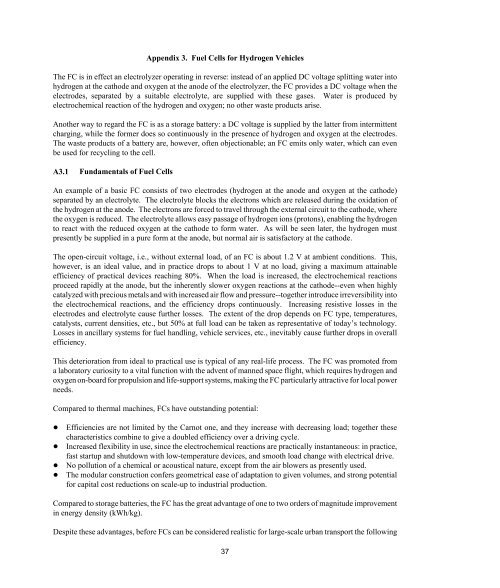Technology Status of Hydrogen Road Vehicles
Technology Status of Hydrogen Road Vehicles
Technology Status of Hydrogen Road Vehicles
You also want an ePaper? Increase the reach of your titles
YUMPU automatically turns print PDFs into web optimized ePapers that Google loves.
Appendix 3. Fuel Cells for <strong>Hydrogen</strong> <strong>Vehicles</strong><br />
The FC is in effect an electrolyzer operating in reverse: instead <strong>of</strong> an applied DC voltage splitting water into<br />
hydrogen at the cathode and oxygen at the anode <strong>of</strong> the electrolyzer, the FC provides a DC voltage when the<br />
electrodes, separated by a suitable electrolyte, are supplied with these gases. Water is produced by<br />
electrochemical reaction <strong>of</strong> the hydrogen and oxygen; no other waste products arise.<br />
Another way to regard the FC is as a storage battery: a DC voltage is supplied by the latter from intermittent<br />
charging, while the former does so continuously in the presence <strong>of</strong> hydrogen and oxygen at the electrodes.<br />
The waste products <strong>of</strong> a battery are, however, <strong>of</strong>ten objectionable; an FC emits only water, which can even<br />
be used for recycling to the cell.<br />
A3.1 Fundamentals <strong>of</strong> Fuel Cells<br />
An example <strong>of</strong> a basic FC consists <strong>of</strong> two electrodes (hydrogen at the anode and oxygen at the cathode)<br />
separated by an electrolyte. The electrolyte blocks the electrons which are released during the oxidation <strong>of</strong><br />
the hydrogen at the anode. The electrons are forced to travel through the external circuit to the cathode, where<br />
the oxygen is reduced. The electrolyte allows easy passage <strong>of</strong> hydrogen ions (protons), enabling the hydrogen<br />
to react with the reduced oxygen at the cathode to form water. As will be seen later, the hydrogen must<br />
presently be supplied in a pure form at the anode, but normal air is satisfactory at the cathode.<br />
The open-circuit voltage, i.e., without external load, <strong>of</strong> an FC is about 1.2 V at ambient conditions. This,<br />
however, is an ideal value, and in practice drops to about 1 V at no load, giving a maximum attainable<br />
efficiency <strong>of</strong> practical devices reaching 80%. When the load is increased, the electrochemical reactions<br />
proceed rapidly at the anode, but the inherently slower oxygen reactions at the cathode--even when highly<br />
catalyzed with precious metals and with increased air flow and pressure--together introduce irreversibility into<br />
the electrochemical reactions, and the efficiency drops continuously. Increasing resistive losses in the<br />
electrodes and electrolyte cause further losses. The extent <strong>of</strong> the drop depends on FC type, temperatures,<br />
catalysts, current densities, etc., but 50% at full load can be taken as representative <strong>of</strong> today’s technology.<br />
Losses in ancillary systems for fuel handling, vehicle services, etc., inevitably cause further drops in overall<br />
efficiency.<br />
This deterioration from ideal to practical use is typical <strong>of</strong> any real-life process. The FC was promoted from<br />
a laboratory curiosity to a vital function with the advent <strong>of</strong> manned space flight, which requires hydrogen and<br />
oxygen on-board for propulsion and life-support systems, making the FC particularly attractive for local power<br />
needs.<br />
Compared to thermal machines, FCs have outstanding potential:<br />
! Efficiencies are not limited by the Carnot one, and they increase with decreasing load; together these<br />
characteristics combine to give a doubled efficiency over a driving cycle.<br />
! Increased flexibility in use, since the electrochemical reactions are practically instantaneous: in practice,<br />
fast startup and shutdown with low-temperature devices, and smooth load change with electrical drive.<br />
! No pollution <strong>of</strong> a chemical or acoustical nature, except from the air blowers as presently used.<br />
! The modular construction confers geometrical ease <strong>of</strong> adaptation to given volumes, and strong potential<br />
for capital cost reductions on scale-up to industrial production.<br />
Compared to storage batteries, the FC has the great advantage <strong>of</strong> one to two orders <strong>of</strong> magnitude improvement<br />
in energy density (kWh/kg).<br />
Despite these advantages, before FCs can be considered realistic for large-scale urban transport the following<br />
37













